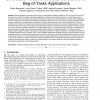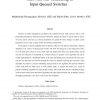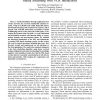TPDS
2008
13 years 11 months ago
2008
The localization of sensor nodes is a fundamental problem in sensor networks and can be implemented using powerful and expensive beacons. Beacons, the fewer the better, can acquire...
TPDS
2008
13 years 11 months ago
2008
IEEE 802.15.4 is a new standard uniquely designed for low-rate wireless personal area networks. It targets ultralow complexity, cost, and power for low-rate wireless connectivity a...
TPDS
2008
13 years 11 months ago
2008
Multiple applications that execute concurrently on heterogeneous platforms compete for CPU and network resources. In this paper, we consider the problem of scheduling applications ...
TPDS
2008
13 years 11 months ago
2008
We present NRMI: a drop-in replacement for Java RMI that supports call-by-copy-restore semantics for arbitrary linked data structures, in addition to regular call-by-copy semantic...
TPDS
2008
13 years 11 months ago
2008
Queue length oscillation at a congested link causes many undesirable properties such as large delay jitter, underutilization of the link and packet drops in burst. The main reason ...
TPDS
2008
13 years 11 months ago
2008
Energy efficiency is one of the most critical issues in the design of wireless sensor networks. Observing that many sensor applications for object tracking can tolerate a certain d...
TPDS
2008
13 years 11 months ago
2008
Fairness in traffic management can improve the isolation between traffic streams, offer a more predictable performance, eliminate transient bottlenecks, mitigate the effect of cer...
TPDS
2008
13 years 11 months ago
2008
Real-time image transmission is crucial to an emerging class of distributed embedded systems operating in open network environments. Examples include avionics mission replanning ov...
TPDS
2008
13 years 11 months ago
2008
Application-layer peer-to-peer (P2P) networks are considered to be the most important development for next-generation Internet infrastructure. For these systems to be effective, lo...
TPDS
2008
13 years 11 months ago
2008
Media distribution through application-layer overlay networks has received considerable attention recently, owing to its flexible and readily deployable nature. On-demand streaming...



